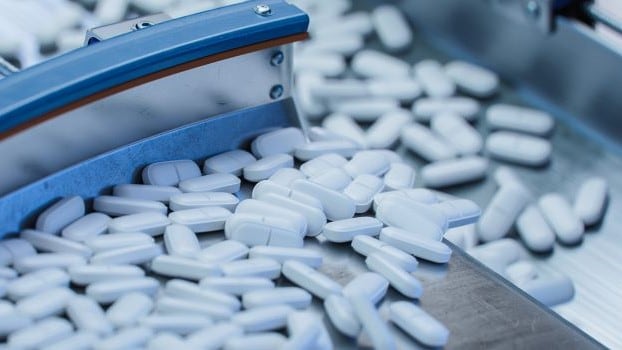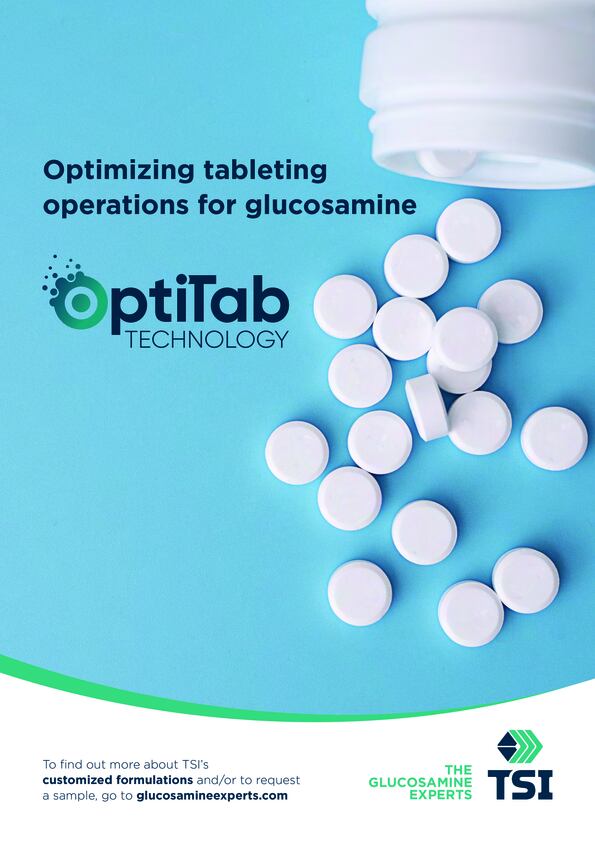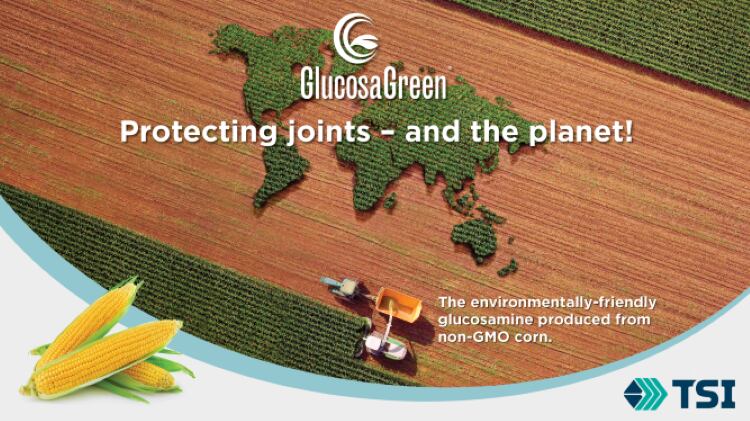Glucosamine is notorious for being problematic when being tableted, here’s how to ensure your glucosamine exceeds expectations for an ever-widening consumer base.
There are raw material suppliers of commodity ingredients, and then there are singular ingredient experts, the next generation of ingredient purveyors. When investing in a new supplement that has widespread awareness and thus demand, it is wise to work with a company that doesn’t just hand over the ingredient via shipment but instead has expertise in all its challenging characteristics and properties, and how to overcome them.
The natural products industry continues to become more sophisticated, as does the healthy lifestyle consumer. Commodity ingredients still enjoy lofty positions as front-of-mind in their categories, for example, vitamin C for immune support and glucosamine for joint support.
The global glucosamine market is expected to reach $757.3 million in two years according to market research firm Grand View Research Inc.
The TSI team understands that producing finished glucosamine tablets has always been a challenging process, and tablet manufacturers have learned to rely on adding more excipients or focusing on particle size distribution of the raw glucosamine to achieve what they consider to be optimal results. They have accepted these limitations as the best they can achieve without understanding there is opportunity for further improvement.
As an example, conventional glucosamine powder is inherently difficult to compress into tablets. When making a tablet containing glucosamine, manufacturers typically aim for a daily dose of 1500 mg per one tablet. Even when using a direct compressible granule, microcrystalline cellulose (MCC) is often added as an excipient by the tablet manufacturer to improve compressibility and hardness, however any added ingredients will naturally increase the size of the tablets. This creates a conundrum: 1500 mg glucosamine in a single tablet leaves very little room for other potentially necessary excipients or lubricants before the tablet becomes too large to swallow. Using TSI Glucosamine DC allows for the manufacturer to reduce or even eliminate MCC and still achieve good tablet hardness. Tablet manufacturers can lower raw material costs and reduce their processing time, while still producing a finished product that contains fewer broken tablets, fewer tablets with uneven edges, and fewer yellow spots.
The problem is exacerbated when other active ingredients are combined with glucosamine to create complex formulas.
Glucosamine is facing a growing number of competitors, such as collagen and turmeric, in the joint health space. Glucosamine is one of the category originals, and TSI has been there since the beginning of its dominance and has thus been able to engineer its development to help produce what consumers expect in a glucosamine tablet.
The net benefits you gain when working with an expert in a single ingredient such as glucosamine for tablet production include lower cost, superior quality and more flexibility to distinguish your glucosamine products in the marketplace.
TSI manufactures the raw glucosamine, granulates it and also produces finished products. The company’s glucosamine knowhow creates tremendous benefits for tableting, such as:
- Avoiding tablets that are too large, or as an alternative, avoiding doses that require multiple tablets – both of which are highly undesirable from the consumer standpoint;
- Minimizing tablets that are broken, chipped, discolored, or falling apart, which are also characteristics that will repel re-purchase;
- Making sure all tablets have consistent dosage levels when there are multiple ingredients in the formulation; very important in meeting label claims.
Cost-efficiency when working with an expert supplier is always at the forefront and this is not always achieved with traditional glucosamine. TSI, through its research and development, is capable of allowing substantial cost savings. For example, tableting machines can run faster, providing higher yields because less compression force is needed. This also reduces wear and tear on the tableting equipment. With TSI’s direct compression (DC) glucosamine granules, tablet manufacturers save precious time and cost on materials such as excipients; this amounts to increased efficiency and quality of yield – dramatically reduced unusable tablets (broken, chipped, easily disintegrated, misshapen).
The DC Ddifference
Traditional glucosamine doesn’t compress when it is in powder form; therefore, it must be in direct compression (DC)-grade granules for effective processing into tablets. The current industry practice where DC granules are measured by particle size distribution (PSD) does not fully reflect suitable compressibility for tableting. The granules should exhibit high compressibility because PSD alone creates a variability that can have significant impact on operational efficiencies and outcomes.
The key to making a viable tablet with glucosamine is using a granule with the desired compressibility – not just a specified PSD. TSI, with joint expertise in raw material supply and tablet manufacturing, measures the compressibility of every batch to make sure manufacturers can compress the best tablet (not just to deliver on PSD as per spec requirements).
Using DC granules enables production of smaller tablets with better hardness, uniformity and disintegration time, and without chipping and capping, as well as reduces excipients, improves tablet aesthetics, improves operational efficiency and reduces overall costs. The right (high compressibility) granule is the basis of a tablet that performs as the consumer expects and allows for a cleaner label.
TSI’s next-generation glucosamine can produce tablets with low friability even with no MCC and about 1% magnesium stearate. For example, a manufacturer making a tablet that includes 20% glucosamine HCL, 8% chondroitin, 10% methylsulfonyl methane (MSM) and 6.6% green-lipped mussel was adding 24% MCC and was still unable to compress the tablet. When using TSI’s glucosamine HCl DC they were able to compress and in fact was able to reduce the amount of MCC in the formulation.
TSI owns a finished-dose contract manufacturing facility that has been producing more than 400 varied formulations of glucosamine and glucosamine &and chondroitin tablets during the past decade. The company manufactures the raw materials, granulates (and co-granulates glucosamine and chondroitin), and also can produce finished products. It is the only company in the world that manufacturers both glucosamine and chondroitin.
As glucosamine becomes more relevant for younger adults who are concerned about maintaining joint health through a high-fitness lifestyle, this expands demand for effective glucosamine tablets beyond the senior population. But you need to get it right the first time.







